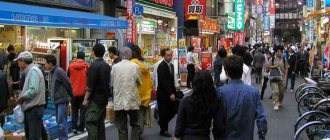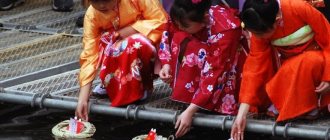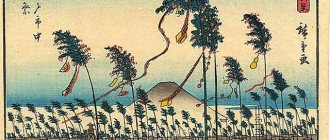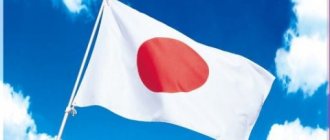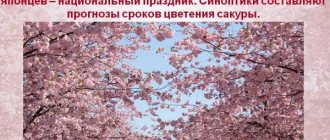What is Bon and how is it celebrated in Japan?
Bon is celebrated annually at different times: in the west of Japan - in mid-July, in the east - in mid-August. These days, according to beliefs, the souls of the dead visit the living. The date of this holiday changes every year, since according to the ancient Buddhist custom, Bon comes on the seventh full moon of the year.
During the holiday, friends exchange gifts, working Japanese are often given a day off on the last day of the holiday, and many time their vacations to coincide with this time to visit their homes and communicate with both the spirits of their ancestors and living relatives. On these same days, as well as on New Year's Day, workers and employees are paid bonuses (bonuses in Japan are traditionally paid twice a year).
Despite the fact that Bon is the day of remembrance of the dead, this holiday is celebrated cheerfully, colorfully, and noisily. There are many rites, ceremonies, and rituals associated with it. And although the details of its implementation vary depending on the location, the general features are the same everywhere.
On the eve of the holiday, houses are thoroughly cleaned. A special treat is prepared for guests. In front of the home altar (looks like a small niche, it is a must in every, even the poorest, home) a small mat is laid out, on which memorial tablets (ihan) are placed and food is placed for the dead. On ordinary days, such niches contain a vase of flowers or ikebana, a painting or a poem written in calligraphy.
The Japanese go to cemeteries. The graves of the deceased are decorated with sakaki and koyamaki branches (according to the Shinto religion, these trees are sacred), treats are placed on the branches: mochi (rice cakes), fruits, and incense is lit. Fairs are organized where you can buy decorations for the holiday, delicacies, and you can find out your destiny from numerous soothsayers.
Before the day of the holiday comes, countless lanterns are lit everywhere: in cemeteries, in front of houses, on the streets, in parks. These lanterns illuminate the way home for the souls of the dead. And in mountainous areas, people go to cemeteries, carrying birch torches instead of lanterns. Perhaps it is because of the abundance of lighting that Bon is sometimes called the Lantern Festival, although the latter are attributes of many traditional holidays.
On the last day of the Bon holiday, lanterns are lit again to show the souls of the dead the way back. The romantic ritual of launching small paper lanterns on wooden stands, with a lit candle inside, attracts attention. Words of prayer and sometimes the names of the dead are written on the walls of the lanterns. This ceremony is performed wherever there is water: on rivers, ponds, lakes and even in the sea. It is especially colorful in Matsushima, one of the most beautiful places on the Pacific coast of Japan. Here, floating chains of burning lanterns twist whimsically, repeating the intricate bends of the bays.
Bonfires on the mountains around Kyoto, arranged in the form of various hieroglyphs meaning the concepts of “big”, “ship”, “lotus sutra”, “torii”, are extremely popular as options for farewell fires. The red lights against the backdrop of dark mountains are an unforgettable sight. This custom, according to legend, can be traced back to the Muromachi era (14th-16th centuries), but was first mentioned in written sources in 1637 in the chronicle of the Kinkakuji Temple.
The most fun part of the holiday is the dancing - bon-odori, which has accompanied it since the 15th century. During the Bon festival, young and old, men and women, parents and children dance in front of Buddhist and Shinto shrines, in squares, streets, parks, on the seashore, etc. Bon-odori is a rhythmic dance in which those participating sometimes they take graceful poses like living statues, sometimes they sway to the beat, sometimes they spin at an ever-accelerating pace, clapping their hands. The dancing is accompanied by singing and drumming. Songs and dances constantly follow each other, and the singers and dancers are truly tireless. It is especially interesting to observe bon-odari in rural areas.
For us Europeans, Japanese national customs and traditions passed down from generation to generation seem unprecedentedly exotic. But for the Japanese, Bon and other holidays are an organic part of the living culture of our time.
Tags: celebration, customs, holidays, Japan, culture
O-Bon Festival
Japanese language courses in Moscow # Japanese linguistic center # Japanese language learning center # Conversational Japanese language courses # Japanese linguistic center # Japanese center in Moscow
“O-bon” – in Japanese, is a holiday of remembrance of ancestors. The Japanese believe that during the Ko-Bon holiday, the souls of the departed return to their loved ones and they are reunited. The word "ko-bon" is an abbreviation for the Buddhist festival Ullambana (Sanskrit for "hanging upside down", implying great suffering). The sutra tells the story of Mokuren, a disciple of the Buddha, who used his unusual abilities to see his dead mother. Mokuren discovered that his mother was in the realm of hungry ghosts and was suffering greatly.
Worried, he went to the Buddha and asked how he could rescue her. The Buddha advised making offerings of food, incense, and lamps to priests who returned from their summer retreat on the fifteenth day of the seventh month. The disciple listened to the Buddha, and as soon as he followed all his advice, his mother was released. According to legend, the son also understood all the past unselfishness and sacrifice of his mother.
Master the Japanese language # learn Japanese quickly # Japanese textbooks for the Japanese language # Japanese teachers at the Japanese language center # fall in love with the Japanese language #
During the Ko-Bon period, families remember their ancestors and light special lanterns to illuminate the path for the souls of the departed and help them get home faster. The Ko-Bon holiday also has another name - the Lantern Festival. O-bon is not a public holiday, but many Japanese companies give their employees three days off so they can visit and reunite with their loved ones.
The dates for ko-bon celebrations vary: in some areas of Japan this holiday is celebrated from July 13 to 15, in others from August 13 to 15. It is at this time of year that congestion on Japan's highways, railways and airports increases sharply.
“O-bon” is one of the most important Buddhist holidays in Japan. At this time, services are held in churches, accompanied by the reading of sacred books. Relatives make offerings to the souls of the deceased. In the evening, in the parks you can see a large number of Japanese dressed in “yukata” (traditional Japanese clothing, which is a summer casual cotton, linen or hemp kimono without lining). Currently, “yukata” is worn mainly during leisure, worn both at home and on the street. Elegant, bright “yukatas” are worn at festivals by people of all ages. “Yukata” can also often be seen at “onsen” (Japanese for hot spring). “Yukata” is included in the standard set of linen provided to guests in Japanese hotels. To the sounds of folk music and singing, the Japanese perform the bon-odori dance, designed to calm the souls of their ancestors. “Bon-odori” is a dance of remembrance of ancestors and gratitude for their sacrifices. A dance designed to bring joy to family and friends who have passed on to another world.
How to remember Japanese characters # secrets of learning Japanese # Japanese language learning center # Master spoken Japanese # be a master of Japanese # Japanese calligraphy and Japanese language #
“Bon-odori” is accompanied by original music in different parts of Japan. These may be chants related to communication with spirits, or from local folklore. Therefore, holding the Bon-odori holiday significantly depends on the location. A typical “bon-odori” is a round dance around a tall wooden structure (in Japanese - “yagura”), erected especially for the holiday. "Yagura" also serves as a platform for musicians and singers. The dancers circle around the “yagura” clockwise and counterclockwise, approaching the “yagura” or moving away from it. During the dance, the dancers hold in their hands a fan, a towel called “tenugui,” or wooden rattles called “kati-kati.”
The holiday ends with the floating of paper lanterns with burning candles along the river as a symbol of eternal memory and the inextricable connection between those living on earth and those who have gone to another world.
Japanese language courses in Moscow # Japanese linguistic center # Japanese language learning center # Conversational Japanese language courses # Japanese linguistic center # Japanese center in Moscow
Learn Japanese from scratch! This is your compass in modern life.

